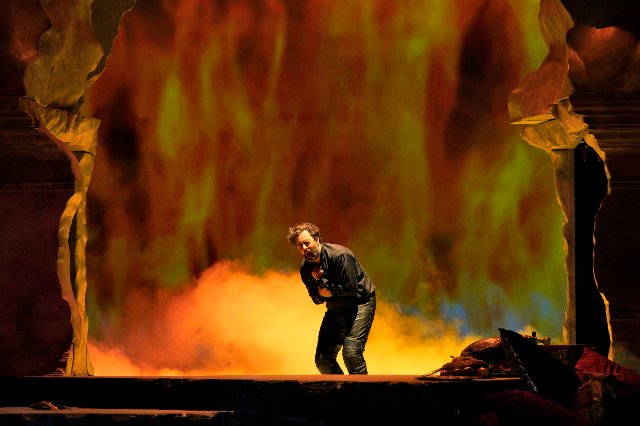Don Giovanni
Produced by San Francisco Opera
By: Victor Cordell - Jun 13, 2022
The sky is fiery ashen orange, reminiscent of the foreboding atmosphere in the Bay Area from the 2021 California wildfires. Fortunately, this post-apocalyptic vision comes not from nature, but rather from the opera stage. Fittingly, San Francisco Opera sets the tale of the morally failed title character in a time of environmental and societal collapse. This is “Don Giovanni” in what could be future America.
Before the pandemic, San Francisco Opera decided to package Mozart’s three greatest Italian-language and Italianate-style operas, “Marriage of Figaro,” “Cosi Fan Tutti,” and “Don Giovanni”" into a trilogy. They also happen to be his three collaborations with the great librettist Lorenzo da Ponte. The common thread of the adaptations is not just that they take place on American soil, but literally on the same plot of earth. For the first installment, it was a Revolution-era home that in the second had been converted into an exclusive club in the 1930s. In the final opera in the series, the stately Greek Revival edifice is crumbling in the dystopia of the year 2080.
The dark comedy “Don Giovanni” holds a place as one of the greatest operas ever composed. In the hands of a world class company like San Francisco Opera with a great orchestra and the ability to attract some of the best artists to grace the stage, the production is as musically rich as it is professionally performed.
Based on the oft-told Don Juan legend, the title character is a womanizing libertine of low moral character, whose only positive trait is his charm, which acts as the fuel for his ability to seduce and rape women with lies and abuse and betray his loyal manservant, Leporello. Among the latter’s less dangerous chores, he actually keeps a log of his master’s thousands of conquests, revealed in the servant’s humorously-delivered signature aria “Madamina, il catalogo è questo.” The Don and Leporello are Etienne Dupuis and Luca Pisaroni respectively, and both give apt portrayals with powerful vocals spanning the bass-baritone range.
Mozart himself loved women, and da Ponte’s libretto offers three very satisfying female roles of fairly equal importance. Although their incidents with Don Giovanni are unrelated, the women’s paths cross and they become collaborators, like a posse hunting down a perpetrator.
Adela Zaharia is Donna Anna, whose steely determination to identify and punish the killer of her father, the Commendatore, is a key driver to the action. Her clear and concise voice reaches its heights in Act 2 with a beautiful coloratura in “Non mi dir,” when she tells her suitor, Don Ottavio, that she is not ready to wed quite yet after the recent tragedy. As Donna Elvira, Nicole Car shares her dramatic vocalization in two ensembles with Don Giovanni and Leporello, “Ah! chi mi dice mai” and “Ah! taci ingiusto core.”
Christina Gansch plays Zerlina, who as a peasant is relegated to lesser treatment. However, she is vocally equal to the other female victims, and she shares with the Don the most memorable music in the opera, the classic duet “Là ci darem la mano.”
This staging of “Don Giovanni” is problematic. On the one hand, it can be accepted as random design and virtually ignored, since the captivating music and complex drama can still be fully appreciated. On the other hand, Director Michael Cavanagh did conceive this as the last piece in the American trilogy. But other than abundant damaged remains of U.S. flag motifs, nothing seems especially American. And although the costumery is supposed to symbolize the repurposing of haberdasher leftovers in this grim futuristic world, that notion doesn’t come across unless the viewer has read the director’s intent. Further, when an orchestra appears on stage, gray-wigged players are in period European uniforms, which is confusing given the time and place of the action.
Separately, the treatment of the Commendatore is undramatic at the outset but stunning at the end. The performer, Solomon Howard, is not made to look old and distinguished, and rather than having some stage time, perhaps as an apparition to establish the sense of the character and situation, he simply descends a staircase and promptly gets killed, making the whole action seem perfunctory and insignificant. Conversely, at the closing, a 24-foot high bust of the Commendatore moves slowly upstage to dramatic music, as clever lighting morphs the ghostly sculpture. A ragged chasm down the center of its face splits open, and a fiery inferno appears in the divide. Quite a spectacle!
As previously noted, it is easy to quibble about the strengths and weaknesses of the production design, however, the bones of this opera will always stand tall, and the fine cast and orchestra deliver a fine experience.
“Don Giovanni,” with music by Wolfgang Amadeus Mozart and libretto by Lorenzo da Ponte, is produced by San Francisco Opera and plays at War Memorial Opera House, 301 Van Ness Ave., San Francisco, CA through July 2, 2022.

